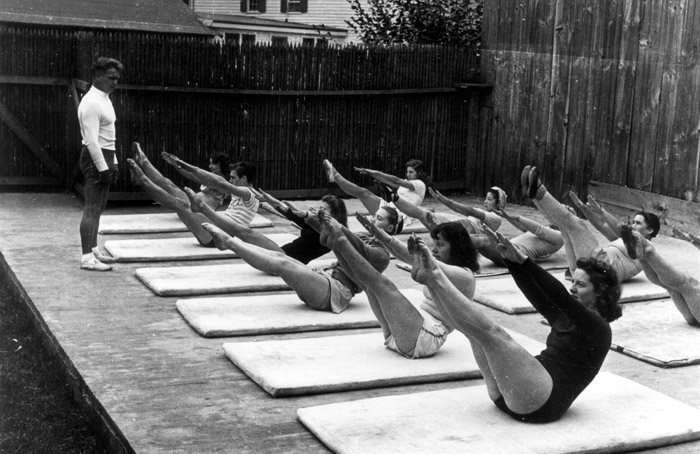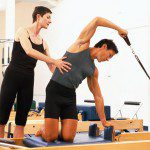In our last blog we discussed the history of Pilates, how it was originally known as Contrology, and that it didn’t find a mainstream following until much later in its existence. Though Joseph Pilates began teaching Contrology in the late 1920’s, it wasn’t until the 1990’s that one could easily find a Pilates studio in your local town. The long, winding road was not an easy one, and this blog will take a look at how Pilates became what we know it as today.
How Did Pilates Survive the 70’s?
After Joseph Pilates passed away in 1967, his widow Clara and a few of his most loyal clients and instructors took on the burden of keeping the doors open to the gym at 939 8th Ave in NYC. Sadly, Joe was not one for signing contracts or keeping good documentation, so after a few years and a number of plans that exceeded their lifespans, the gym would need to close down and find a new path forward. It was in 1972 that Pilates, as it was now called, had a new face and a new location: Romana Kryzanowska and the 56th Street Studio. Romana, a ballerina, had studied a short time with Joseph when she was in her late teens, and though he found her adept at the process, she didn’t stay long at the gym, instead going after her dreams of being a prima ballerina. Now that her dancing days were behind her, this would be her new stage and offer her a chance to shine once more as the Queen of Pilates. With the changing of the guard, so too did the aesthetics and process. While Joe required a minimalistic and old-school design based on simplicity and effectiveness, this new Pilates allowed for individualism and creativity that was more in line with the 1970’s.
Pilates in the 80’s
During the invasion of excess and the “greed is good” theory of the 80’s, Pilates still remained a more refined way of exercise than the fad of aerobics, and therefore it was still not mainstream enough to stay afloat on its own merits. Between 1984 and 1989, there were two different changing of the guards, and eventually, the NYC studio shut down for good. Romana continued to teach privately and in other studios, but it was on the west coast that Pilates found a new beginning. An old student of Joe’s named Ron Fletcher opened a studio in Beverly Hills during the 70’s, and by the mid 80’s had a successful business not only teaching Pilates to locals and celebrities alike, but also training others to continue teaching Pilates around the country. It was also Ron who helped incorporate Pilates into the world of Physical Therapy when he introduced it to an orthopedic surgeon named Dr. James Garrick. Joe’s dream of Pilates being accepted into the world of medicine had finally come to fruition, about fifteen years after his death.
The Revolution of Pilates in the 90’s and 00’s
By 1990, there were over 200 Pilates instructors teaching privately or in small studios. This was a huge change from the gym that Joe ran even in the 60’s, where there were only a handful of assistants that worked under his ever-watchful eye. Now that the medical world had accepted Pilates within the world of physical therapy, it was more popular than ever. But this also made it a target for those who had ill intentions. At one point in the early 90’s, a small-time physical therapist had acquired the trademarks for Pilates and eventually tried to sue anyone who operated a studio and used the Pilates name, along with anyone who created equipment for Pilates use. This led to a hotly contested trial in 2000, but in the end was found that he had no right to “monopolize a method of exercise (or) the generic word used to describe it.” Pilates was now available to anyone who wished to teach it, and it was about to explode in popularity.
Pilates in the Here and Now
No doubt that most who are reading this blog have no idea the history and struggle behind Pilates. Like with most things, as time goes by, the stories of how and why it began gets lost in the shuffle. After reading John Howard Steel’s Caged Lion, many moments have been brought back into the light, albeit from his point of view. While Joseph Pilates was adamant about the structure of classes, the specificity of the exercises, and the Teutonic atmosphere required to be fully focused on the process, Pilates today has evolved into a more palatable and varied experience for all students, encompassing over 14,000 instructors and 11 million practitioners by the mid 2000’s. Though Romana said she taught the one true Pilates method while others made changes according to their needs, John makes a point to state that Romana also introduced more ballet aesthetics into the exercises that Joseph didn’t include. The point is that Pilates is a system of exercise that can be adapted to the needs of the practitioners, and has found itself with a unique spiritual resilience like that found in yoga and martial arts, both of which Pilates borrowed from. While some may say they are the one true Pilates, the classical form will always be the truest, and as long as the basics are held to a high standard, everyone and anyone can find success in what was originally known as Contrology.



